Revista Electrónica de Investigación Educativa
Vol. 2, No. 2, 2000
Professional Trajectory of Engineers in the
Maquiladora Electronics Industry:
The Case of Sanyo Video Components
María Ruth Vargas Leyva
rvargas@tectijuana.mx
Instituto Tecnológico de Tijuana
Montes Apalaches 11
Lomas Conjunto Residencial, 22640
Tijuana, B.C., México
(Received: September 12, 2000;
accepted for publishing: October 18, 2000)
Abstract
This is a study of the career trajectories of engineers in the company Sanyo Video Components. Three stages in the development of the professional career are recognized: initial career stage, mid-career and late stage career. Results indicate that the career’s trajectory is internally determined by the area of career development and job hierarchy. In external mobility, there are limitations of individual and family type; those of an individual type are age and area of career development; those of a family type are civil state, spouse’s occupation and the presence and number of children. The results of other studies are confirmed in relation to the engineers’ practical training in the business, based on the initial career stage, the step from the technical dimension to the administrative, and the decrease in promotion potential which comes with age, as well as the professional conversion process of engineers who have various types of professional training.
Key words: Career trajectory, work trajectories of engineers.
Introduction
The study of career trajectories does not constitute a unified field of research; rather, the studies proceed from a variety of disciplines, and have different objectives. They are related to professional insertion (Vincens, 1997), and according to sociologists, they are linked with identity construction (Hualde, 1990) and gender studies. From a perspective of professional training, they are associated with the construction of competencies (Lanciano and Nohara, 1993). Some studies allude to professional path and career paths.
This work analyzes the career trajectories of engineers in the company Sanyo Video Components. The case study explores the possibility of maintaining the work environment, the company’s culture and the hierarchy of jobs as controlled variables. The trajectory is defined as a sequence of jobs held by individuals during their work history, of jobs, observable and institutionalized, in an ascending and pyramidal path. This work is defined as a first attempt to study the professional trajectories of engineers in the maquiladora industry and to identify regularities and variables that would explain the logic of the career trajectory in the sector.
Bibliographic review
“Career trajectory” is defined as the step from one job to another in the organization, like stairsteps, together with plausible times of reaching them (Sherman and Bohlander, 1996); as a succession of development activities which implies formal and informal education, training and appropriate work experience leading the individual to jobs of upper hierarchy (Byars and Rue, 1995); as a sequence of jobs that includes two or three different fields and two or three different organizations, without a strict job hierarchy that could easily establish the professional trajectory. Recently, study on the trajectories of professional insertion indicate nonlinearity, lack of a unified model, and the historicity of trajectories (Mukamurera,1999), as well as trajectories that can combine periods of unemployment, precarious employments and training courses of various kinds (Outin and Silvera,1993).
Piore (1983) refers to work careers or “mobility chains”; that is to say, a sequence of jobs, observable and institutionalized, in an ascending and pyramidal path, accompanied by periods of training, of experience and of seniority. More recently, the concept of “careers” refers to the sequences of jobs which individuals hold during their work history, independent of the job or the organizational level; it refers not only to vertical mobility in the organization, but also to horizontal mobility. It is not synonymous with employment in a job or organization, and is not understood only as the control of the company over the individual trajectory, but also as a responsibility or the individual.
For Claude Dubar (1990), the notion of professional career constitutes the true objective on which the characteristic socialization of the labor market are based. Dubar identified two very different moments: “the moment previous to insertion which takes place in the external market in a competitive situation, and the moment of internal mobility after insertion in stable employment within an internal market”. In both moments, professional training occupies a strategic place in regulating access to jobs, to the development of professional careers, and to remuneration.
There is strong evidence that the professional career and its characteristics are related to achievements in the initial work phase (Feldman and Arnold, 1997) and determines even the career plateau, a point at which the probability of a new hierarchical ascent is very low; or rather, the unexpected and undesired professional career stagnation called leveling. These moments are associated both with individual characteristics and with certain levels of specialization. Thus, “employees who have reached the plateau have occupied the position for a certain time and have a considerable mastery of it, know the organization and frequently show extraordinary loyalty” (Sherman and Bohlander, 1996: 208); however, they lack “visibility” and have not developed social competencies. In contrast, those who move up the corporate ladder find that there are increasingly fewer jobs available, and that leveling means transfer to another position where responsibilities and remuneration are equal to those of the previous position, increasing employees’ horizontal mobility. It is common for fast-track career trajectories, with great vertical mobility in a short period of time, to locate an individual quickly in the plateau of an organization.
Mobility in the company is colored by the traditional work structure and by the concept of an engineer, not as a universal category, but as a social construct, inseparable from the particular social conditions that produce him. In France, this concept achknowledges time as similar to an educational degree and professional function; those who acquire this latter denomination within the company have access to the status of “middle management”, related with the resolution of empirical problems; while the engineer with a professional degree assumes command functions, and is identified as a “manager”.
In Japan, where an engineering degree is not a prerequisite for entering the company, this recognition is built over time through inservice training, and one arrives at “middle management” on the completion of supervision tasks, after a period of 10 to 15 years of work. Internal mobility is controlled by the company, and external mobility is reduced. Lanciano and Nohara (1998: 12) state that:
In The United States and Great Britain, the engineer is developed in the company, gains her2 status within it, and it is the process of socialization and adaptation that determines her position. In France, the mobility of engineers is related with age and with the school where they studied (graduate school), as well as with the view of position. In the case of Japan, what predominates is the idea of rank, in which there are between five and ten classified grades of competency. All is based on the notation of merit, quantifiable as work attitude, leadership and encoded results. While French engineers are placed in differentiated careers early on, Japanese engineers progressively acquire professional ability which leads, at close to forty years, to a differentiation between those in middle management, and those who are not (Lanciano and Nohara, 1993).
The career trajectory gives meaning to continuous professional development, and to lifelong learning as an individual within a group or within an organization as in everything, reinventing and reorienting oneself again and again, mastering, over time, the complexity and dynamism of the company. On planning the career, people take increased responsibility for their own employability, based on the possession of a variety of communication abilities, teamwork, problem-solving, critical thinking, and a positive attitude toward change, in which transition abilities that allow the individual to advance from one opportunity to another are essential. Recently, the professional career trajectory has been related with the educational deficit of those who have already passed through the educational system: the large number of direct workers, professionals and administrators in early or mid-career stages. “The deficit increases with the failure to achieve a professional development structure beyond that stage of formal qualification” (Duggan, 1995: 142).
In the career trajectory, job hierarchy is related with the jobs’ scope and depth. The scope refers to the number and variety of tasks performed; the depth, to the degree of freedom to plan and organize the work, to move to one’s own rhythm, and to move about and communicate freely. Greater freedom is associated with the management of personnel, and with the flow of the process; less freedom, with the material resources’ level of availability, and with the possibility of implementing new ideas. The trajectory also undergoes: a) the possibility of enlargement of the position, by means of the incorporation of new tasks of similar nature, which means widening its scope; and b) the enrichment of the position or elevation of the work status by the extension of its scope and depth, usually by assuming new functions and responsibilities. For the engineer who is moving up, the first case may mean a transfer; the second, a promotion.
There are recognized three stages in the development of the professional career, which also includes the professional trajectory: initial career stage, mid-career and late stage career. The choice of three stages allows us to compare our results with similar studies using this same apportionment.
The initial career stage includes the process of socialization for becoming part of the organization; it consists of the development of abilities, adaptation to the group and its norms, learning the culture of the organization and the acquisition of contextual knowledge and conduct appropriate to the new employee’s role. It is a critical period in which the work is centered on routine and technical tasks, in processes more than in products, and in familiarizing engineers with the technological level of the company.
The two most important characteristics in this phase are autonomy and responsibility. It is a crucial phase for demonstrating professional competency. In this phase much of the engineer’s formal learning is irrelevant, and his knowledge of the discipline is insufficient in problem-solving. At this stage, the company assesses employees’ potential, and makes decisions regarding the best ways to implement their professional development.
At the mid-career stage, tacit knowledge is acquired in the area of professional development, and one passes from specific and technical tasks to the larger scope and depth of the jobs. The criteria of execution and achievement, which at the beginning of the career are lightly structured, are conducive to vertical mobility and job enrichment. Those who develop social skills and technical and managerial competencies find that the criteria with which they were recruited are not the same as those with which one is promoted, and that the rapidity of promotion declines after the first few years. Promotion includes a variety of factors, and as individuals acquire additional responsibilities, their professional scope expands, their growth agenda increases exponentially and the knowledge required becomes interdisciplinary. Promotion can include “being in the right place at the right time” at a stage where there is an increase in competitive pressure, derived from the rapid change in knowledge, and of the constant organizational changes in the company.
In the late stage career, individuals, depending on their professional trajectory, have achieved a level of technical or managerial specialization. They have a broad vision of the company and a profound knowledge of its products, which, on occasion, is used specifically in the socialization of new engineers. However, there are few opportunities for vertical mobility, the scope of the position is reduced and the depth decreases. The individual is near retirement, or is on a dead-end career path.
In the case of engineers, planning the professional career can take two routes: the technical and the managerial. At the beginning of a career, the technical skills, which can be applied to a variety of industries, facilitate insertion into the labor market with higher incomes, but as specialization in a company increases, the number of jobs suitable for ascent is reduced, and the probabilities of employability in another company or sector decrease. In contrast, those who have general skills and who enter the company with disadvantages accumulate significant learning and develop skills that extend their trajectory within the company. By and large, “in big companies, the career trajectories are short for those who have technical skills, as compared with those who have general skills” (Takata and Curran, 1999).
The empirical evidence indicates that the professional trajectory of engineers begins in a more technical dimension, and ends in a more administrative one (Mukamurera, 1999), that the mobility in the early phase determines the career trajectory (Rosenfield, 1992), and that employment reduction becomes critical between the ages of thirty-five and forty years (Lavoie and Finnie, 1996), when the engineer is submitted to an extensive process of professional conversions which leads from a formal specialization to a specialization in the company (Dore and Sako, 1998).
These findings indicate that there is a close relation between the initial training received, and the first employment (Weisner, 1993), and that in the majority of cases, the engineer’s practical training begins only after joining the company (Imano, 1994).
Normally, plans and career trajectory are based on each individual’s performance potential, which facilitates making decisions as to whether to continue the trajectory in the company; move across the market recruited by another company; or get out of the market, opting for a second career. These decisions are affected by the goals and expectations of the individual concerning the job and the company.
There is little evidence regarding the work of engineers in modern sectors of the economy. The studies of Hodson (1988), of Grosseti and Mas (1990) and of Lavoie and Finnie (1996) analyzed, respectively, the mobility of engineers in modern sectors in the United States, the trajectories of insertion in France, and the accumulation of skills in recent engineering graduates in Canada. In the case of the maquiladora industry, the trajectory of professional identity has been studied (Hualde, 1995) as well as engineers’ professional practice (Vargas, 1999)—in both cases, in the sector’s electronics branch.
Interest in the history of engineers in the maquiladora electronics industry derives from the some studies’ supposition that changes in the work offer and changes in the work itself have effects on the stability of employment and on the professional career, both in insertion and in internal mobility, threatened by socio-technical changes that oblige a certain operational re-composition of the operative functions. On the other hand, there is arising a widespread belief that individuals should have total control of their own careers, relating this process to alternate paths of professional career development in highly-structured companies.
Methodology
Methodology
In this work, the career trajectories of engineers in the company Sanyo Video Components are analyzed. The trajectory is defined as a succession of observable and institutionalized jobs, in an ascending and pyramidal course, which individuals hold during their work history; the analysis of the trajectory is perceived as the structure on which the development of the professional career rests. The substance of the analysis alludes to the stages of the career: initial career stage, mid-career and late stage career, and to the factors that foster internal and external mobility. Otherwise, we would be working with an analysis of work trajectory only, and would be limited concerning the possibility of explaining the underlying logic.
Its importance stems of the contribution of empirical evidence related to the way the engineers’ professional trajectory, the impact of professional training on the trajectory, and the factors associated with internal and external mobility.
The results are from a case study on a company using Japanese capital, a company established in Tijuana ten years ago: Sanyo Video Components. The firm is located in the Pacific Industrial Park, and makes yokes, fly backs and tuners.3 This company is made up of two plants certified in ISO 9000 and ISO 14 000, as well as having won, in 1999, second place in the Company category of the competition for National Award for Conservation of Energy. Among its benefits, the Sayno offers a clinic of the Mexican Social Security Institute; elementary, junior high school and high school facility; low-cost cafeteria; and company scrip which can be used in exterior stores—common in the maquiladora industry. There is a total of 1387 employees: 1053 company workers, 60 engineers, 274 administrators and nine Japanese staff members. The case study allows detailed documentation of the career trajectory and the opportunities for mobility in a context of decision-making with regard to promotion.
Sixty members of the Middle Management staff were interviewed (high-level technical personnel, support personnel for the administrative and production personnel). Fifty of these are engineers, six are non-engineers with engineering jobs,4 seven are in production support, and four are in human resources and training. In the sample analyzed, 50% are engineers, 10% are supervisors, 14% are general supervisors, and 3% are assistant managers.
The instrument used to carry out the structured interview was discussed with the company before it was applied, and diagnostic inservice training on the impact of the training program was offered. The results of this are not discussed in this document. The field work was done from May to August of 1999. This period saw the external mobility of three engineers. In the month of August, the General Manager of the company was hired by another plant, in the same branch, in a position of the same hierarchy, and with a better salary. As a consequence, the job hierarchy was restructured, and horizontal and vertical mobility of engineers presented itself. From August of 1999 to January of 2000, the organigram of the company was restructured, and the position of General Supervisor was renamed Area Manager. Implementation of this plan saw the ascent of six engineers and the external mobility of another six, five of whom were from the same sector.
Results
Results
Of those surveyed, 82% are men. Sixty-five percent of the engineers had a paying job while they studied, often in work related with their training. The insertion work was obtained through a company advertisement (25%), by applying personally (15%), or through social relations (15%). The other 40% were contracted at school, during their professional service,5 through employment agencies and by the use of other strategies. Of the 41 engineers who had finished their studies, five were women; 33% had obtained their degrees,6 two persons had technical degrees, and three more had not finished college. Recruitment is concentrated on electronics engineers and industrial engineers. The term “engineers in training” refers to engineering students working as engineers. The term “engineering technicians” indicates personnel with technical-level studies, and who acquire the designation of engineer within the company, linked to the resolution of empirical problems and in middle-management jobs; they have a wide knowledge of other engineers, derived from a knowledge of the products and the process. The support personnel is made up of a variety of professionals like accountants and those with B. A.’s in International Business (see Table 1).
Table 1. Training characteristics of Middle
Management personnel
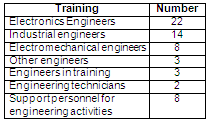
The composition of Middle Management takes into account of the interface between the local system of higher education (50% of the engineers) and the national system of technical education (technological institutes) from which come 72% of Middle Management employees (see table 2). There is also a strong current of professional migration 42%); the reasons stated were the prospect of greater employment opportunities and the social networks established among graduates. This professional migration has been constant due to the presence of a dynamic labor market, and to population growth in Mexico’s northern border region.
Table 2. Institutions from which Middle
Management employees come
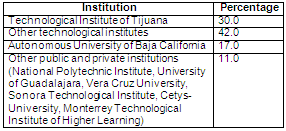
Of those interviewed, 26% said they were not using their professional training. This is due to their entering the maquiladora sector because they could not find work in another sector, and to their specialization in a particular profession. There are therefore industrial electrical engineers working as quality engineers; fishing engineers working as manufacturing engineers, or chemical engineers in departments of quality control. All this leads to professional conversion processes.
The number of employment changes in the career trajectory shows a mobility of as many as six jobs, with a relative stability in two and three positions, where the engineers construct their career trajectory in the internal market. The percentages of those who say that Sanyo Video Components was their first job, and those recruited in the last three years, point to a significant mobility presented at the beginning of the mid-career state. The data indicate that only three engineers, betwee 37 and 45 years old, have been at Sanyo since the company opened, with no promotion during the last five, eight and nine years; and that vertical mobility is found more frequently among those recruited between 1994 and 1996, while horizontal mobility is concentrated among those recruited in the 1997-1999 period (see Table 3).
Table 3. Number of jobs held during
the career trajectory
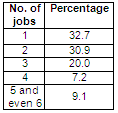
At the time of the interviews, 36% of the staff, ranging in age from 24 to 34 years, had received ascensions in the last eight months (see Table 4), 16% to the level of supervisor, while 18.7% of those with a mean age of 39 years had remained without promotion for 4 to 8 years. Recent mobility occurred in individuals in mid-career, usually associated with a recent process of management change and the company’s efforts in hierarchical restructuring. Nonmobility prevailed in manufacturing and production engineers averaging 39 years of age, both in those with work experience in up to six companies, and in those who had experienced only internal mobility. The only constant was that none had obtained a professional degree, highlighted as the strongest limitation to ascent.
Table 4. Job stability

To analyze the potential for ascent, four categories of persons were identified by career: “apprentices”, “stars”, “serious citizens” and “dead weights” (Byars and Rue, 1995). Each of the persons in these categories has a potential career or has come to leveling-type jobs, usually in an unplanned way, supported or limited by cognitive, technical and social characteristics (see Table 5).
Table 5. Classification of potential for ascent in the career
(adapted from Byars and Rue, 1995, p.290)
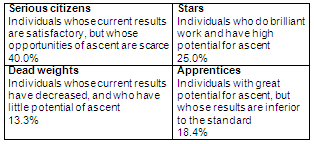
The results permit us to infer an effective recruitment system and a potential human resources recruitment which translates to 40% of the personnel with satisfactory results, and 25% with a brilliant performance. The category of “apprentices” includes those recruited during the 1998-1999 period. In 80% of the cases, the vertical mobility predominated, concentrated in the “serious people” close to the plateau; in “stars” with high mobility potential; and in two cases of apprentices with fast-track trajectories. The company’s strategy tends toward specialized training, characterized by an ascending territorial logic of Production Engineer to Supervisor of Bobbin-winding, Production Supervisor, and later on, to General Supervisor of Production; with a rapid mobility of “apprentices” to “stars”, and in a few cases, of “apprentices” to “serious citizens”. Some individuals in the category of “stars” will continue in fast-track careers ascending to positions of general management, while others move on to the category of “serious citizens”. This strategy produces, at mid-career, an accumulation of learning and experience in both categories, which without adequate remuneration, produces mobility in the labor market.
Classification of the personnel according to its ascent potential indicates a concentration of human capital as “serious citizens”, “stars”, and “apprentices”. These last, located in production and production-support activities, constitute the company’s competitive potential. Generally, mature and highly-competitive industries like that of televisions, in a region where all the companies, as to their offer, are represented in an oligarchy, tend to employ “serious citizens” to a greater extent than those focused on new company technologies that require a high percentage of innovative human resources.
The reasons for the engineers’ mobility points to dissatisfaction with their remuneration; only 2% said they are paid minimum wage, and 5% receive compensatory benefits. Only 22 % of the engineers were satisfied with their salaries; those who want a raise in salary indicated eight types of desired stimuli, preferably economic (see Table 6). This piece of data reinforces the result showing adequate remuneration as a key factor for remaining in the company. However, mobility is associated with the recognition of personal productivity and quantifiable achievements; this lack of recognition is the factor most cited by those looking for opportunities outside the company.
Table 6. Types of stimuli requested by
Middle Management
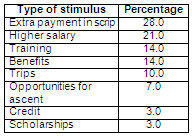
The scope and depth of the position are increased in accordance with the hierarchy, so that they are greater for an Engineer C than for an Engineer A. However, they are lesser in the maintenance areas; lesser in project engineering than in product engineering; with a greater scope and depth in manufacturing and quality engineering. This same result follows the description and functions of the jobs of the general supervisors, so that the scope of and the depth is greater in the case of the engineering and quality supervisors, and lower for general supervisors of materials and maintenance.
The important choice is that of the professional specialization area. The attractive choices do not always lead to rapid mobility and middle management and managerial scenarios. Design engineers require high intellectual demand and higher theoretical knowledge in an area very specific and well-paid, but limited in professional mobility, unless the company maintains a policy of two alternate routes for the professional career. On the other hand, the engineers with greater scope and depth in their position are those in production; the ascent in this area is more rapid than in others, beginning with the exercise of leadership, greater visibility and the possibility of interpreting any activity and its results as a tangible indicator, such as productivity and quality costs.
With regard to the engineers’ external mobility, this is related as much with individual limitations as with family limitations. In the first case, age is the dominant area in the career trajectory (which includes experience and formal and informal learning), the hierarchical position in the company, and the potential for mobility; in the second, it is the civil state, the wife’s occupation, the presence or absence of children and the size of the family. The impact of these variables increases or diminishes depending on the state of the career trajectory; the impact of family limitations tends to diminish with advance in the trajectory and to increase the impact of individual limitations. The work offer in the external market acts as a intervening variable, since there is a permanent demand for engineers.
In the initial career stage, remaining in the company is motivated by the accumulation of learning and by professional experience, enriched by a variety of current activities and by those perceived as future. The individual evaluates other options based on an expectation of the accumulation of experience and learning within the company, so that she chooses not to have external mobility, up to the point at which she perceives a general competency in the sector and a specialized one in the area, in a combination of theoretical knowledge and practical experience. To Rosenfeld (1992), this phase presents, up to the third year, opportunities which fundamentally affect the professional career.
In mid-career, being single is an influence toward external mobility; in the case of the married, external mobility is influenced by the wife’s having gainful employment, and if there are children, by having a smaller number. These variables influence the way engineers perceive the comparative advantages of continuing in the company or moving out of it. However, this last decision, in most cases, is an effect of expulsion from the company, so that job characteristics such as low pay, no benefits, and other stimuli lead to external mobility, for the purpose of improving present and future monetary income.
This conclusion is reinforced by the engineers’ perception of their interaction with colleagues and with immediate superiors (see Table 7), and with the opinions of the company as “a learning space” with a cordial environment; with independence regarding work, and with good communication; with performing a creative task offering a high level of responsibility, “different from other Japanese companies”. In spite of that, 20% of the engineers said they were looking for employment, and two “stars” and a “apprentice” had already been hired by another company. In every case, inadequate remuneration for the person’s skills and for individual achievements was cited as the strongest motive for the external mobility.
Table 7. Perception of the work environment

The decision to stay in the company or leave it involves assessment of the advantages, so that the advantages of staying (motivated by opportunities for professional development, recent internal mobility and adequate remuneration) must be greater than those of leaving. These advantages are is not assessed only with reference to a difference in pay, but also regarding learning in a company whose technological characteristics and whose potential for growth may or may not be greater. Evaluation also concerns immediate opportunities and rapid ascent to a high hierarchical status, plus recognition of accumulated experience and technological learning. Usually, remuneration is the basic item of comparison when decisions are being made about a change of employment; the minimum differential of remuneration for external mobility is between thirty and fifty percent, besides other benefits. The greatest external mobility is found in engineers who have accumulated experience in areas of greater demand in the external market, such as production, manufacturing and quality; and in individuals with a high potential for ascent, or “stars”. The lowest external mobility is found in engineers specializing in an area with little demand, such as that of design, or technology transfer; in those individuals whose results are satisfactory, but whose opportunities for ascent are scarce—in whatever stage of the professional career—and who have arrived at the plateau and who stay on it for a period longer than four years (see Table 8).
Table 8. Options for change in the career trajectory
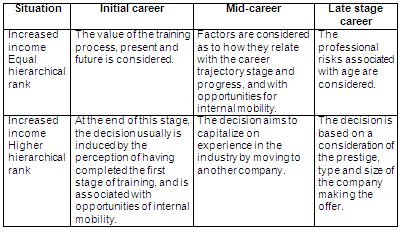
The career trajectories are basically developed in four areas: design, production and manufacturing, quality, and maintenance. In the area of design, there is a concentration of electronics engineers; in production and manufacturing, there are engineers with a variety of training: industrial, mechanical, electrical and systems; the area of quality control shelters industrial engineers, biochemists and chemical engineers, and industrial chemical engineers.
In contrast, the maintenance area recruits more electrical engineers, electromechanical engineers, and electricians. In turn, these areas have higher or lower external mobility potential, depending on the external market. Those who carry out activities of design have fewer possibilities for external mobility, given the specialized nature of their tacit knowledge and the number of companies in the sector who have incorporated design activities. Professional practice in production is characterized by longer trajectories in activities that combine both technical and human aspects; while the area of manufacturing, with its greater concentration on technical aspects, has more frequent mobility toward the position of Assistant Manager. In both cases there is a greater possibility of capitalizing on accumulated experience in the external market of the sector and of other sectors. The area of quality control cuts across all the areas and increases the possibility of internal and external mobility in the sector, particularly for those with experience in quality systems ISO 9000 and ISO 14 000. The maintenance area shows reduced opportunities for internal and external mobility, due to the technological heterogeneity of the sector. It may be deduced that in the absence of early conversion, it is professional training which largely determines the area of professional development, and is also the determining factor in the existence of a greater or lesser number of opportunities in the external labor market.
In the late-stage career, staying in the company is directly related with age, professional trajectory and remaining in a position, as well as with the number and age of the engineer’s children. Internal mobility is reduced, and external mobility, should it be offered, is perceived as directed toward a position or to a definite project in a smaller or more recently established company, usually as a senior engineer; this implies a reduction in scope, but an increase in depth.
Career trajectories point to early ascending mobility for high-potential engineers who come to the management area between the ages of 30 and 35. However, the probability of promotion depends on the creation of opportunities, on the creation of jobs, and on the demands and remuneration of the external market. Thus, promotion and remuneration is partly determined by the external market in terms of quantitative and qualitative demands.
In the case of Sanyo Video Components, the diploma, as an expression of having obtained a professional degree, is not a relevant criterion for promotion. A chemical industrial engineer and a technician in industrial analysis ascended to the same position in the same time, although by trajectories which, in the case of the person with technical training, indicate an ascent based on the hierarchical structure (see Table 9).
Table 9. Career trajectories to Area Manager. Production area
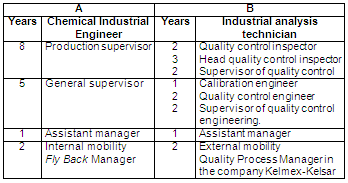
Even in the same area, the trajectories that take one to supervisory positions, present differences. In this case (C and D), the engineers were contracted as recent graduates, without previous work experience. In the case of the women, two are in the initial career phase (E and F), and one is General Quality Supervisor. The three trajectories started from the lowest rung of the hierarchical ladder; the women said they had greater difficulty in their ingress to the company, previous work experience in smaller companies, and came from a technological institute in another state (see Tables 10 and 11).
Table 10. Career trajectory to Supervisor. Engineering area
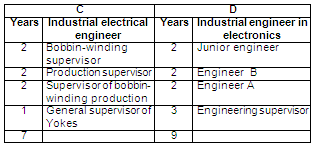
Table 11. Career trajectories of two engineers. Design area

In the case of the engineers, mobility is associated with variables like personality and gender, and with uninterrupted career trajectories.
One of the characteristics of Sanyo Video Components is the mobility of the engineers up to Plant Manager, as opposed to companies that recruit for this position in the external market. This may have influenced engineers of under 30 years to point out the position of Plant Manger as the most desirable hierarchical position, while engineers between the 35 and 48 years old, having a more realistic attitude toward their ascent opportunities, aspired to become Area Managers.
There is no particular trajectory which ensures continuous ascent to jobs of higher hierarchy. However, the route to becoming Plant Manager requires a combination of technical and managerial skills involving working one’s way through the production area. Greater knowledge of the product and an overall vision of the company and corporation, as well as offering possibilities for career ascent, are essential for the promotion. The trajectory involves the journey of Engineer A, B and C to Supervisor, Supervisor to General Supervisor, of Assistant Manager to Area Manager, and from General Manager to Plant Manager. Each product creates a hierarchy of jobs that go from Engineer to Supervisor of Fly Back, Tuners and Yokes. The technical areas offer opportunities for high specialization; however, remaining in them past the initial career stage leads to the absence of “stepping-stone” jobs for ascent; at least one could capitalize on this training and experience in another company in the labor market. Generally, the engineers’ trajectory begins in a technical area and moves toward administrative activity.
Conclusions
Even when the internal market does not clearly define the requirements for jobs, the promotion criteria and the viable career trajectories offer mobility opportunities determined by ascents, few descents, and mobility outside the company. In the insertion process, the majority of the engineers do not have a trajectory project for their professional careers, are recruited for the company in general rather than for a specific position, and are placed early on in different careers, depending on their professional training and employability characteristics. Their future mobility is determined in the initial phase both by their capacity for socialization and their tangible results. Thus, in the first three years they are expected to evolve from “apprentices” to “stars” or to “serious citizens”.
There are no unique trajectories in the internal market; trajectories depend on the diplomas that allow insertion into the labor market, on specialized professional training, on mobility in the initial phase of the career, and on individual aptitudes for exploiting the opportunities offered by the company, related with the growth of the plant, the jobs vacant and the individual and family reorganizations whose impact varies at different moments of the career trajectory. The itineraries of the engineers do not appear as a division between the types of responsibilities, but as an enriched position in the same area. Usually, there are different trajectories leading to a position, and the position can lead to different future opportunities. Career trajectories tend to be in the same sector, with greater external mobility in some areas than in others. In addition, the difference between staying in the company or leaving—as regarding future prospects—is influenced by both individual and family limitations.
The frequent lack of a relationship between professional training and professional trajectory can be explained by Sanyo’s recruitment policy, which consists of a process of internal training (often including six- to twelve-month stays in Japan), plus training sessions within the company. The process of professional conversions has been little studied, nor has there been much investigation of the role played by the professional degree in labor market insertion and professional career development. By and large, the Sanyo engineer is modeled on the traditional training plan of the Japanese company, unlike the French or German models analyzed by Lanciano and Nohara (1993).
Some aspects in common with other, similar studies is the practical training of the company’s engineers after the initial career stage, the step from the technical dimension to the administrative, the impact of the professional training in the area of professional career development, and the decrease in promotion opportunities with age; as well as the conversion process of those engineers who have a variety of professional training. The results indicate the need for a more profound study of the dissimilarities in various company contexts and cultures, apart from those of the case studied.
The study allows better understanding, in a context of decision-making, of the logic involved in the career trajectory, identifying individual and family variables which determine both the internal and external mobility of the engineers, as well as the impact of professional training on professional development. Studies on other companies and other sectors will confirm or refute these results.
References
Byars, Lloyd L., & Rue, L. W. (1995). Gestión de recursos humanos. Mexico: Interamericana.
Dore, R. P., & Sako, M. (1998). How the japanese learn to work. Nissan Institute y Routledge Japanese Studies. Serie London: Oxford Press.
Dubar, C. (1990). La evolución de la socialización profesional. In Francois M. & Denis S. (Comps.). El empleo, la empresa y la sociedad (pp. 169-179). Madrid: Ministerio de Trabajo y Seguridad Social.
Duggan, Terance V. (1995). Engineering Education in the context of lifelong learning. Australasian Journal of Engineering Education, 6, (1), 135-145.
Feldman, D. C. & Arnold, H. J. (1997). Managing individual and group behavior in organizations. New York: McGraw-Hill.
Grosetti, M. & Mas, P. (1990). Un mercado local de trabajo: los ingenieros de Toulose. In Michon, F. & Segestin D. (Comps.). El empleo, la empresa y la sociedad. (p. 141-153). Madrid: Ministerio de Trabajo y Seguridad Social.
Hodson, R. (1988). Good Jobs and Bad Management: How New Problems Evoke Old Solutions in Hig-Tech Settings. In Farkas G. & England, P. (Eds.). Industries, Firms, and Jobs: Sociological and Economic Approaches. (pp.247-279). New York: Plenum Press.
Hualde, A. (1990, September). Ingenieros en la frontera norte de México: trayectorias laborales e identidades profesionales. Paper presented at meeting “Tendencias y manifestaciones de la nueva cultura del trabajo”. UAM-Azcapotzalco &Friederich Ebert Foundation.
Koichiro, I. (1994). De’ roulement de carrière et developpment des ressources humaines au niveau du personnel de R/D dans les entreprises japanaises. Proceedings Les acteurs de l’innovation technique dans l”entreprise. París: Económica, 83-97.
Lanciano, Caroline y Nohara, Hiroatsu. (1993). The Socialization of Engineers and the Development of Their Skills. Training & Employment. Newsletter No.13. Centre d'Etudes et de Recherchers sur les Qualifications, 5-11.
Lavoie, Marie y Finnie, Ross. (1996). The Early Careers of Engineers and the Accumulation of Skills in the Canadian Economy. The Research Paper Series, 4-28.
Mukamurera, J. (1999). Le processus d’ insertion professionnelle de diplomés en enseignement au Québec: une analyse de trajectoires. Education et Francophoni. Perspectives d’avenir en education, 27 (1). Retrieved from: http://www.Acelf.ca/revue/XXVII/articles/Mukamurera.html
Outin, Jean-Luc & Silvera, R. (1990). Mercado local de empleo y reconversión: Le Creusot. In F. Michon & D. Segestin (Comps.). El empleo, la empresa y la sociedad. (pp. 155-168). Madrid: Ministerio de Trabajo y Seguridad Social.
Piore, Michael. (1983). Notas para una estratificación del mercado de trabajo. In L. Toharia. El mercado de trabajo. Teorías y aplicaciones. Madrid: Alianza Universidad.
Rosenfeld, R. A. (1992). Job Mobility and Carrer processes. Annual Review of Sociology, 39-61.
Sherman, A. W. & Bohlander, G. W. (1996). Administración de los recursos humanos. Mexico: Grupo Editorial Iberoamérica.
Takata, S. R. & Curran, J. (1999). “Theory, Policy, Practice of a Career”, Faculty on the Site. Domínguez Hill, California State University. Retrieved february 18, 2000, from: http://www.wup.edu/academic/sociology/Takata.html
Vargas Leyva, Ruth. (1999). Reestructuración industrial, educación tecnológica y formación de ingenieros. México: ANUIES.
Vinces, Jean. (October-December, 1997). L’Insertion professionnelle des jeunes. A la recherche d’une definition conventionnelle. Formation et emploi, 60, 37-45.
Weisner, Gerhard. (1993). La gestion des ressources humaines dans la recherche-développment: une comparaison Allemagne-Japon. Problèmes économiques, 19, 23-35.
Translator: Lessie Evona York-Weatherman
UABC Mexicali
2Earlier in the twentieth century, English, like Spanish, used the masculine possessive pronoun in generalized statements to indicate both genders of humankind. Since the advent of the feminist movement, however, such usage in English has been considered sexist, is generally avoided, and has been replaced by expressions such as “his and her”, “s/he” etc. (Fennel, Francis, 2002). While these non-sexist devices can be comfortably employed now and then in a work, their constant and continual use becomes awkward. In this work, in order to avoid the annoying repetition of such constructions, we shall at times use the feminine pronoun (she, her, etc.) and at times, the masculine (he, him, his, etc.).
3The “yokes” are the deflection coils on the monitor which direct the electron beam to display the television image; the “fly back” is the high voltage section of the amplifier of high voltage; the “tuner” tunes in to television channels.
4In Mexico, the title “Engineer” (Ing.), and other professional titles (Arquitecto [Arq.], Contador [Cont.], etc.), is used the way the title “Dr.” is used in the United State, and applies only to those persons who have obtained the degree and certification. Whereas in the United States a person who is doing engineering work would be considered an “engineer”, in Mexico, this is not so.
5All Mexican college students, not only those in the field of medicine, must serve an “internship” in his chosen field before receiving their degrees. This internship period is called the “professional service”.
6In Mexico, the degree is not conferred automatically upon graduation; after completing one’s studies, one must either take a professional examination or write a thesis, or both, in order to obtain the degree. Also required is the donation of a certain number of hours of community service, plus a designated number of unpaid work hours in one’s chosen field (see note 5). These requirements apply to every student, in every field.
Please cite the source as:
Vargas, R. (2000). Professional trajectory of engineers in the maquiladora electronics industry: The case of Sanyo video components. Revista Electrónica de Investigación Educativa, 2 (2). Retrieved month day, year from: http://redie.ens.uabc.mx/vol2no2/contents-vargas.html






![]()



